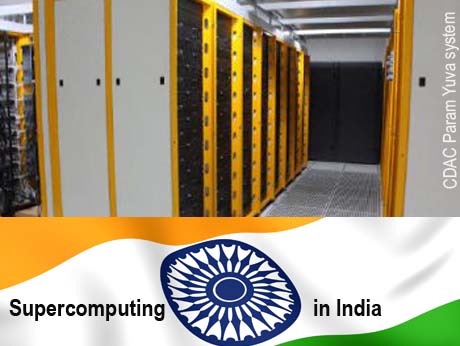
New Delhi, March 26 2015: The Cabinet Committee on Economic Affairs, chaired by Indian Prime Minister Narendra Modi, has green lighted a National Supercomputing Mission aimed at enabling India to leapfrog to the league of world-class computing nations.
The Mission responsibility is to be shared bty two government entities: the Department of Science and Technology (DST) and Department of Electronics and Information Technology (DeitY) and a budget of Rs 45 billion has been allocated, spread over seven years. The Centre for Development of Advanced Computing (C-DAC) and the Indian Institute of Science (IISc), Bangalore will be the twin operational hubs of the project.
The Mission is to install a National Supercomputing Grid of some 70 high-performance computing (HPC) facilities, over the National Knowledge Network (NKN). The NKN is another programme of the government which connects academic institutions and R&D labs over a high speed network.
The Mission when completed, would bring supercomputing within the reach of the large Scientific & Technology community in the country, says the government's note on this development. It will provide significant qualitative and quantitative improvement in R&D and higher education in the disciplines of Science & Technology; and enable the country with a capacity of solving multi-disciplinary grand challenge problems. The Mission is part of government’s vision of “Digital India” and “Make in India” initiatives.
IndiaTechOnline comments:
This "new" initiative appears to be a case of old wine in new bottle.
Back in January 2012, the then Prime Minister announced a national supercomputing mission to be funded with Rs 50 billion with the aim to take Indian supercomputers to the peta flop league. There has been little progress since then as the agency then charged with the mission -- the IISc seemed better geared to buy rather than make the necessary system -- a view not shared by other stakeholders like CDAC who believe in the long run, HPC technology needs to be largely home grown for any number of strategic reasons.
It would seem from the latest announcement that the two agencies are being put in joint harness to draw the same wagon and it remains to be seen how the ideological position of buy-versus-build shakes out.
In January 2014, some 24 months after the 2012 announcement, the National Supercomputing Mission for India set itself a short term, 3-year target, to set up three petaflop-scale facilities, networked into a grid. Twenty high end terra-scale facilities located in academic institutions, universities and research labs and 50 medium range terra-scale would also be created and networked, government then said.
One year and more later, it seems a case of "jaise they" or 'as you were' -- only the kitty has shrunk by a some 5 billion rupees -- presumably eaten away in administrative expenses since 2012. The clock has again be reset so that 4 years have been wiped out and the target is again 7 years away.
In an Internet age where the moving window of HPC computing speeds, adds a few peta flops every few months, to achieved performance, all this will seem like an extremely relaxed and laid back attitude. But maybe this is our way of saying 'better late than never'.
Our earlier reports:
Dec 2014: India home to less than 2% of world's supercomputers
Jan 2012: India bets $ 1 billion to regain supercomputing clout
Jan 2014: India to buy and build her way to exascale computing